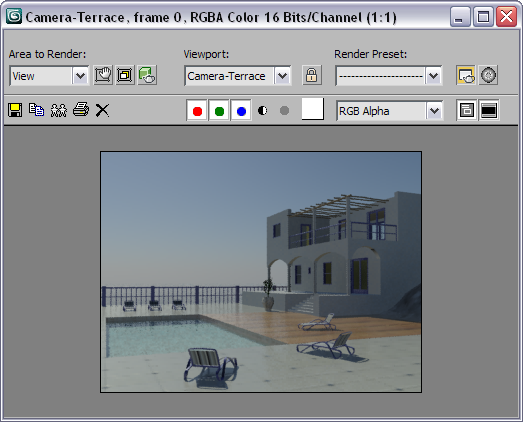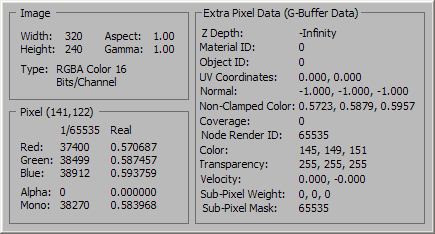The Rendered Frame Window displays rendered output.
When you choose the View Image File command from the Rendering menu, 3ds Max displays still images and image sequences in a feature-reduced version of the Rendered Frame Window. When you view sequentially numbered image files or images in an IFL file, this window displays navigation arrows that let you step through the images.
The Rendered Frame Window Title Bar
The title bar of the Rendered Frame Window includes this information:
For example, a full-color image with an alpha channel will show “RGBA Color 16 Bits/Channel”; a bitmap with a limited color depth might show “Indexed Color 8 Bits/Pixel,” and so on.
To zoom and pan in the Rendered Frame Window:
You can zoom in and out and pan the image in the Rendered Frame Window. You can even do this while a scene is rendering.
If you have a wheel mouse, you can use the wheel to zoom and pan:
 Preferences dialog. Go to the Viewports panel, and in the Mouse Control group choose the Pan/Zoom option (this is the default).
Preferences dialog. Go to the Viewports panel, and in the Mouse Control group choose the Pan/Zoom option (this is the default).
This first section documents the controls on the main Rendered Frame Window. For information about the additional control panel that appears below the main window when using mental ray, see mental ray Rendering Options.

Rendered Frame Window Rendering Controls
These controls provide access to rendering settings such as presets and the viewport to render, as well as the Render command. To toggle display of these controls, click the Toggle UI button at the right end of the Rendered Frame Window toolbar.
This drop-down list provides the available Area to Render options. Choose View, Selected, Region, Crop, or Blowup.
When using Region, Crop, or Blowup, set the region with the Edit Region control (see following). Alternatively, you can set the region automatically to the current selection with the Auto Region Selected option (also see following).
 Edit Region
Edit RegionEnables manipulation of the region window: resize by dragging the handles, and move by dragging inside the window. When Area To Render is set to Region, you can edit the region both in the Rendered Frame Window and in the active viewport.
If Area To Render is set to View or Selected, clicking Edit Region switches to Region mode.
When Area To Render is set to Crop or Blowup, you can edit the region only in the active viewport, because in those cases the Rendered Frame Window doesn’t necessarily reflect the same area as the viewport. Hence, also in Crop and Blowup modes, a warning icon appears to the right of the Auto Region Selected. The icon’s tool tip suggests that you edit the region in the viewport. A warning also appears in Region mode if the Rendered Frame Window area doesn’t match the active viewport.
Turning on Edit Region automatically activates the Show Safe Frames function in the active viewport.
 Auto Region Selected
Auto Region Selected Subset Pixels (of selected objects)
Subset Pixels (of selected objects)When on, rendering the scene applies only to selected objects. Available only when rendering with mental ray.
This option differs from the Area to Render  Selected option in that it takes into account all scene elements that affect its appearance. This includes shadows, reflection, direct
and indirect lighting, and so on. Also, Selected replaces the entire contents of the Rendered Frame Window (except for selected
objects) with the background color, but Subset Pixels replaces only pixels used by the re-rendered, selected objects.
Selected option in that it takes into account all scene elements that affect its appearance. This includes shadows, reflection, direct
and indirect lighting, and so on. Also, Selected replaces the entire contents of the Rendered Frame Window (except for selected
objects) with the background color, but Subset Pixels replaces only pixels used by the re-rendered, selected objects.
Subset Pixels rendering is particularly useful when performing iterative rendering while adjusting lighting, shadows, and other scene elements for a particular object or set of objects in the scene. It lets you re-render repeatedly to view the results of isolated changes without disturbing the rest of the rendered output.
The equivalent Render Setup dialog control is Subset Pixel Rendering  Render changes to selected objects only.
Render changes to selected objects only.
 [warning]
[warning]This warning symbol appears when Area to Render is set to Crop or Blowup, accompanied by a tool tip that tells you to edit the Crop or Blowup region in the viewport. It also appears in Region mode if the Rendered Frame Window doesn’t show the same area as the viewport (that is, if you previously rendered in Crop or Blowup mode).
Shows the viewport that renders when you click the Render button. The drop-down list contains all visible viewports. To specify a different viewport to render, choose it from the list or activate it in the main user interface.
Activating a different viewport in the main interface automatically updates this setting if Lock To Viewport is off.
 Lock To Viewport
Lock To ViewportWhen on, only the viewport active in the Viewport list renders, even if you activate a different viewport in the main interface. However, you can still choose a different viewport to render from the list.
When off, activating a different viewport in the main user interface updates the Viewport value.
Choose a preset rendering option from the drop-down list.
 Render Setup
Render SetupOpens the Render Setup dialog.
 Environment and Effects Dialog (Exposure Controls)
Environment and Effects Dialog (Exposure Controls)Opens the Environment and Effects dialog to the Environment panel. You can set an exposure control on the Exposure Control rollout.
Choose the result of clicking the Render button:
Use this option when doing quick iterations on the image, usually in parts; for example, working on final gather settings, reflections, or specific objects or areas of the scene.
This choice is also available from a drop-down in the bottom-left corner of the Render Setup dialog. And you can render in either mode from the render flyout on the main toolbar.
 Save Image
Save Image Copy Image
Copy ImagePlaces an exact copy of the visible portion of the rendered image on the Windows clipboard, ready for pasting into a paint program or bitmap editing software. The image is always copied as displayed, so, for example, if the Monochrome button is on, the copied data consists of an eight-bit grayscale bitmap.
 Clone Rendered Frame Window
Clone Rendered Frame WindowCreates another window containing the displayed image. This allows you to render another image to the Rendered Frame Window and compare it with the previous, cloned image. You can clone the Rendered Frame Window any number of times. The cloned window uses the same initial zoom level as that of the original.
 Print Image
Print Image Clear
Clear Enable Red Channel
Enable Red Channel Enable Green Channel
Enable Green Channel Enable Blue Channel
Enable Blue Channel Display Alpha Channel
Display Alpha ChannelDisplays the alpha channel.
 Monochrome
MonochromeLists any channel rendered with the image. When you choose a channel from the list, it is displayed in the Rendered Frame Window.
For most kinds of files, only the RGB and alpha channels are available. If you render an RPF file or RLA file, additional channels can be present.
The Rendered Frame Window displays nonvisual channels, such as Material ID or the G-Buffer, using colors it assigns at random to distinct values.
Stores the color value of the last pixel you right-clicked. You can drag this color swatch to other color swatches in 3ds Max. Clicking the color swatch displays the Color Selector, which displays more information about the color.
You can leave the Color Selector displayed while you right-click over other pixels in the Rendered Frame Window. (Changing the current value in the Color Selector changes the color swatch on the Rendered Frame Window's toolbar, but it does not change the color of pixels in the rendered image.)
 Toggle UI Overlays
Toggle UI Overlays Toggle UI
Toggle UIThis setting appears on the Rendered Frame Window toolbar when you render to the RPF or RLA file format. It lets you see the information at different layers of the following channels:
Layer shows no additional information for other channels. It is useful primarily when the scene contains objects that occlude each other, and you have turned on the Render Occluded Objects toggle for these objects. (See Object Properties.) Be aware that rendering occluded objects increases render time.
 Frame-Steps (arrows)
Frame-Steps (arrows)When viewing sequentially numbered files (such as image0005.jpg) or IFL files, the arrows display the next or the previous file in the sequence. To jump to the first image or the last image in the sequence, hold down Ctrl and click an arrow.
Available only when you use the View Image File command on the Rendering menu.
When you right-click the Rendered Frame Window, the color swatch is updated, and information about the rendering and the pixel beneath the mouse is displayed.
If you hold the right mouse button down while dragging, the information changes with each new pixel the mouse crosses.

Pixel information includes the pixel location in the bitmap, in parentheses following the Pixel group heading. The counting starts at 0. For example, in the above illustration, the pixel in question is the 308th from the left edge and the 141st from the top edge. Also shown in this group are channel values for red, green, blue, alpha, and monochrome, both as 16-bit integers (0 to 65535) and as floating-point values between 0.0 and 1.0.
Extra Pixel Data (G-Buffer Data) group
If the rendering output uses a format that contains additional channels, such as RPF or RLA, the informational pop-up shows this data in the Extra Pixel Data group. The group includes all the possible channels. If a channel is not present, its value is displayed as "N/A," for "not applicable."
Displays the object’s G-Buffer Object ID.
Displays the sub-pixel weight of a fragment. The channel contains the fractions of the total pixel color contributed by the fragment. The sum of all the fragments gives the final pixel color. The weight for a given fragment takes into account the coverage of the fragment and the transparency of any fragments that are in front of a given fragment.